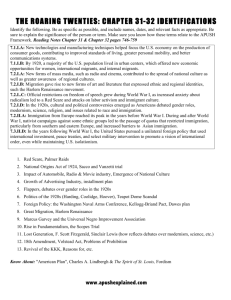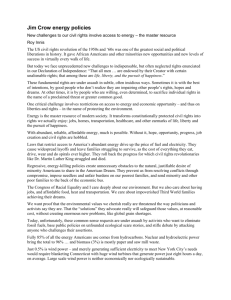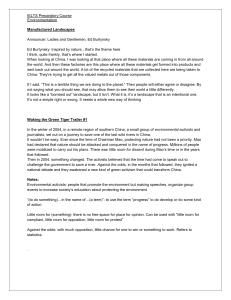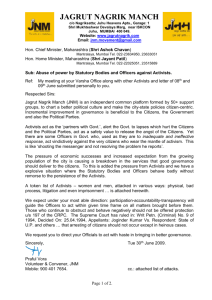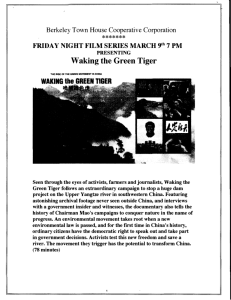Mr. Dennie's AP US History Review Sheet
advertisement
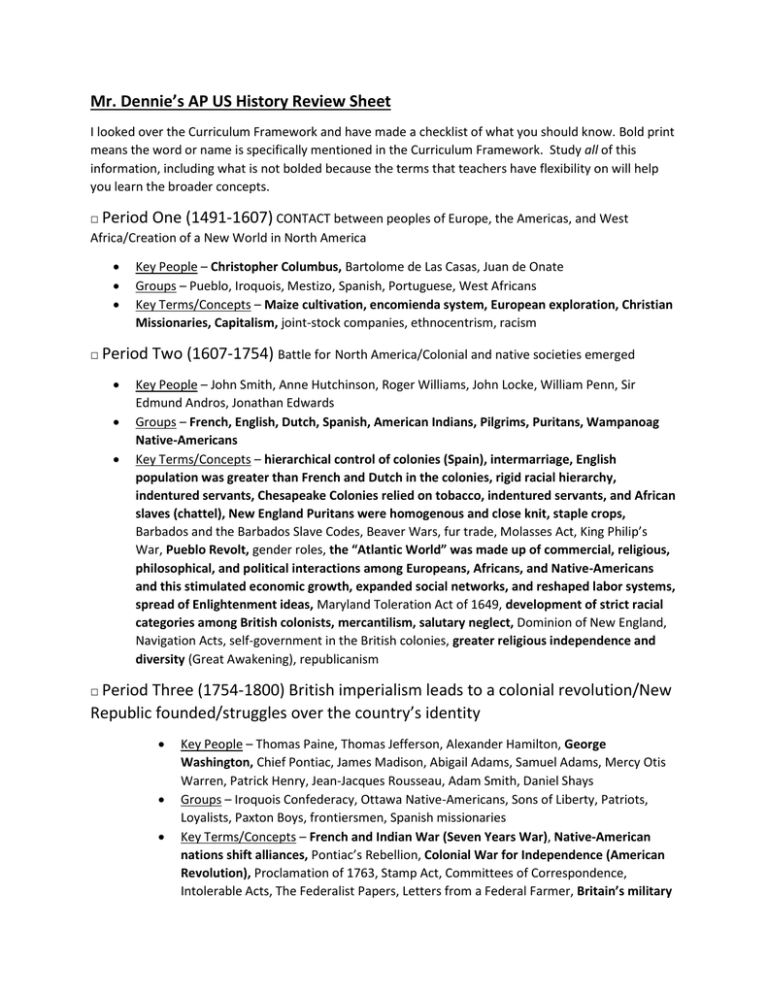
Mr. Dennie’s AP US History Review Sheet I looked over the Curriculum Framework and have made a checklist of what you should know. Bold print means the word or name is specifically mentioned in the Curriculum Framework. Study all of this information, including what is not bolded because the terms that teachers have flexibility on will help you learn the broader concepts. □ Period One (1491-1607) CONTACT between peoples of Europe, the Americas, and West Africa/Creation of a New World in North America Key People – Christopher Columbus, Bartolome de Las Casas, Juan de Onate Groups – Pueblo, Iroquois, Mestizo, Spanish, Portuguese, West Africans Key Terms/Concepts – Maize cultivation, encomienda system, European exploration, Christian Missionaries, Capitalism, joint-stock companies, ethnocentrism, racism □ Period Two (1607-1754) Battle for North America/Colonial and native societies emerged Key People – John Smith, Anne Hutchinson, Roger Williams, John Locke, William Penn, Sir Edmund Andros, Jonathan Edwards Groups – French, English, Dutch, Spanish, American Indians, Pilgrims, Puritans, Wampanoag Native-Americans Key Terms/Concepts – hierarchical control of colonies (Spain), intermarriage, English population was greater than French and Dutch in the colonies, rigid racial hierarchy, indentured servants, Chesapeake Colonies relied on tobacco, indentured servants, and African slaves (chattel), New England Puritans were homogenous and close knit, staple crops, Barbados and the Barbados Slave Codes, Beaver Wars, fur trade, Molasses Act, King Philip’s War, Pueblo Revolt, gender roles, the “Atlantic World” was made up of commercial, religious, philosophical, and political interactions among Europeans, Africans, and Native-Americans and this stimulated economic growth, expanded social networks, and reshaped labor systems, spread of Enlightenment ideas, Maryland Toleration Act of 1649, development of strict racial categories among British colonists, mercantilism, salutary neglect, Dominion of New England, Navigation Acts, self-government in the British colonies, greater religious independence and diversity (Great Awakening), republicanism □ Period Three (1754-1800) British imperialism leads to a colonial revolution/New Republic founded/struggles over the country’s identity Key People – Thomas Paine, Thomas Jefferson, Alexander Hamilton, George Washington, Chief Pontiac, James Madison, Abigail Adams, Samuel Adams, Mercy Otis Warren, Patrick Henry, Jean-Jacques Rousseau, Adam Smith, Daniel Shays Groups – Iroquois Confederacy, Ottawa Native-Americans, Sons of Liberty, Patriots, Loyalists, Paxton Boys, frontiersmen, Spanish missionaries Key Terms/Concepts – French and Indian War (Seven Years War), Native-American nations shift alliances, Pontiac’s Rebellion, Colonial War for Independence (American Revolution), Proclamation of 1763, Stamp Act, Committees of Correspondence, Intolerable Acts, The Federalist Papers, Letters from a Federal Farmer, Britain’s military advantages vs. Patriot advantages, Challenges to early American Neutrality, Debate over the French Revolution, Washington’s Farewell Address, Enlightenment Philosophers, Paine’s Common Sense, Jefferson’s Declaration of Independence, Articles of Confederation, Property Qualifications for Voting, Federalism, Bill of Rights, compromises made to ratify the U.S. Constitution, the U.S. Constitution, Spanish restrictions on navigation of the Mississippi River and the lifting of those restrictions, Kentucky and Virginia Resolutions, Hamilton’s Financial Plan, Neutrality Proclamation, Pennsylvania’s Gradual Emancipation, Northwest Ordinance banned slavery in the Northwest Territory and dealt with education and adding new states, Effect of American Revolution in France, Haiti, and Latin America, westward migration, battles with Native-Americans, continued British presence on the American continent, Jay’s Treaty, Pinckney’s Treaty, development of political parties (Federalists vs. DemocraticRepublicans), REPUBLICAN MOTHERHOOD □ Period Four (1800-1848) The U.S. struggled to define itself and struggled to live up to its democratic ideals/rapid economic, territorial, and demographic changes. Key People – John Marshall, President Thomas Jefferson, President Monroe, President James K. Polk, Charles G. Finney, Elizabeth Cady Stanton, Susan B. Anthony, Henry David Thoreau, Ralph Waldo Emerson, Frederick Douglas, William Lloyd Garrison, David Walker, Nat Turner, Samuel Slater, Lydia Maria Child, President Andrew Jackson, Henry Clay, John C. Calhoun Groups – Cherokees, New Englanders, Southerners, Westerners, Shakers, Oneida Community, Transcendentalists, American Indians, Free-African-Americans, Growth of slaves in the deep South, the British Key Terms/Concepts – Federalism, Federalists fade, Democrats vs. Whigs, Marshall Court, Marbury v. Madison, Market Revolution, New England opposition to the Embargo, debates over the B.U.S. (and the tariff, and internal improvements), The Second Great Awakening, Abolition, Women’s Rights, Seneca Falls Convention, American Colonization Society, emergence of a new national culture with regional sensibilities, Hudson River School, slave music, Social hierarchy, reform movements, technological innovation (examples, the telegraph, canals, railroads), Lowell System, coal mining, economic specialization (Southern Cotton, Northeastern manufacturing, connection of the Northeast to the West with the “American System”), Effects of the Market Revolution, Monroe Doctrine, The Missouri Compromise, annexation of Texas, Manifest Destiny, Indian Removal Act, nullification crisis, Hartford Convention, War Hawks, over cultivation in the Southeast led to relocation of slaveholders and slaves to the Southwest (Louisiana and Mississippi, and Texas were considered Southwest at that time) □ Period Five (1844-1877) The country grew (Manifest Destiny) and tensions grew over slavery (sectionalism)/Civil War/Reconstruction Key People – Dred Scott, Abraham Lincoln, Commodore Perry, President Polk, Zachary Taylor, Frederick Douglass, Harriet Tubman, John Brown, Harriet Beecher Stowe, Stephen Douglas, William Lloyd Garrison, Jefferson Davis, Ulysses S. Grant, Andrew Johnson, Hiram Revels, Robert Smalls, Thaddeus Stevens, Charles Sumner, Sojourner Truth Groups – Mexicans and Mexican-Americans affected by the Mexican-American War, AsianAmericans (Japanese, Chinese), Irish Catholics, Know-Nothings, African-Americans, Hispanics, American Indians, Abolitionists, slaves in the new territories, Republicans (Fremont, Lincoln), Democrats, Confederates, African-American troops, Union Army, Confederate Army, Radical Republicans, Moderate Republicans, Women’s rights activists Key Terms/Concepts – Manifest Destiny, Mexican-American War, clipper ships, expedition to Japan, immigration, Know-Nothings’ anti-Catholic riots, Asian, African-American and white peoples sought opportunities and refuge in the West, Homestead Act, Sand Creek Massacre, Little Big Horn, Northern economy expanded, Abolitionists mount a more visible campaign, states’ rights, racist stereotyping, Kansas-Nebraska Act of 1854, Dred Scott v. Sandford, Whigs vs. Democrats is replaced by the Democrats vs. Republican party system, Election of 1860, Northern advantages in the Civil War, Emancipation Proclamation, destruction of the South’s infrastructure, Gettysburg, The 13th Amendment, Union reunited, Southern resistance to Reconstruction, 14th and 15th Amendments, Redeemers, The 14th Amendment established judicial principles that were stalled for many decades but eventually became the basis for court decisions upholding civil rights □ Period Six (1865-1898) The U.S. industrialized and urbanized/Great Economic, political, social, environmental, and cultural changes. Key People – Homer Plessy, Rockefeller, Carnegie, J.P. Morgan, William Graham Sumner, Mother Jones, Samuel Gompers, James Weaver, Carrie Chapman Catt, Susan B. Anthony, Chief Joseph, Boss Tweed, Henry George, Jane Addams, Edward Bellamy, Booker T. Washington, Ida Wells Key Groups – Businessmen, Farmers, Populists, Knights of Labor, A.F.L., Grangers, Women’s Rights Activists, “New Immigrants” (Italians, Russians Jews, Greeks, Poles), American Indians, Nativists, segregationists, Labor Activists Key Terms/Concepts – Government subsidies (financial support, land grants) for transportation and communication systems opened new markets in North America, Monopolies sought to maximize the exploitation of natural resources and labor, consolidation of corporations, Social Darwinism, “conspicuous consumption,” more diverse workforce, wider gap between rich and poor, “How the Other Half Lives” (Jacob Riis), more middle management and growing middle class (but the Curriculum Framework leaves this out), sharecropping, tenant farming, Sierra Club, Mechanized agriculture (McCormick Reaper) lowered farm prices causing hardship for farmers, Railroad monopolies added to the farmer’s grievances, “New Immigrants” migrate to cities, assimilation (“Americanize”), to some degree immigrants sought to maintain their unique identities, Political machines help immigrants and exploit them at the same time, Settlement Houses help immigrants, Land-Grant Colleges, Federal government violated treaties with Native-Americans, Chinese Exclusion Act, Dawes Act, Ghost Dance, Wounded Knee Massacre, Gilded Age Politics, socialism, Interstate Commerce Act, “Jim Crow,” Plessy v. Ferguson, “Gospel of Wealth” by Carnegie, “Looking Backward” by Bellamy, Social Gospel, Women and African-American activists articulated alternative visions of political, social, and economic equality. □ Period Seven (1890-1945) America became more pluralistic/faced domestic and global challenges/debated the proper role for government/sought to define its international role/became more interventionist Key People – William McKinley, Eugene V. Debs, Theodore Roosevelt, Woodrow Wilson, Warren G. Harding, Calvin Coolidge, Herbert Hoover, Franklin Roosevelt, Florence Kelly, Ida Tarbell, Alice Paul, Lincoln Steffens, Huey Long, Charles Coughlin, Edward Hopper, Langston Hughes, Sacco and Vanzetti, Charles Schenck, William Howard Taft, Winston Churchill, Joseph Stalin Groups – Progressives, liberals, conservatives, New Deal Democrats, Demagogues, Conservative Republicans of the 1920s, African-American artists of the Harlem Renaissance, Bolsheviks, Communists, Southern African-Americans (large numbers went North during the “Great Migration”), radicals, anti-imperialists, imperialists, interventionists, isolationists, JapaneseAmericans Key Terms/Concepts – Large Corporations came to dominate the U.S. economy/new technologies, techniques, production of consumer goods, closing of the frontier in 1890 and Turner’s Frontier Thesis, Spanish-American War, “The New Woman,” in the 1890s, “Muckrakers” write about the ills of society, “Big-Stick Diplomacy,” “Dollar Diplomacy,” Progressive reformers worked to reform political institutions at all levels of government and helped address social problems associated with industrialization and consolidation, Pure Food and Drug Act, Clayton Anti-Trust Act, The Federal Reserve Board, Initial neutrality in WWI then intervention, Wilson’s stated reasons for WWI, unrestricted submarine warfare, Global ramifications of World War I, WWI and the restrictions on civil liberties, wartime (WWI) propaganda, League of Nations, “Red Scare,” restrictions on immigration in the 1920s (Quota Act of 1924), increased credit (1920s, “installment buying), radio in the 1920s and 1930s, motion pictures, automobiles in the 1920s, jazz, Cultural Conflicts in the 1920s, isolationism in the 1920s and 1930s, the Great Depression led to calls for the creation of a stronger regulatory system, The New Deal, Unions in the 1930s, Supreme Court limited the New Deal’s scope, Realignment of 1932, FDIC, Pearl Harbor changes public opinion toward WWII, mass mobilization for WWII, WWII provided opportunities for minorities and women, Japanese internment in WWII, dropping the atomic bomb in WWII, political and military cooperation in WWII, Atlantic Charter, U.S. becomes dominant after WWII. □ Period Eight (1945-1980) Post World War II/Cold War/”The Affluent Society” struggles to live up to its ideals Key People – Harry Truman, Joseph McCarthy, Dwight Eisenhower, Linda Brown, Martin Luther King, Rosa Parks, Thurgood Marshall, Jack Keroac, Allen Ginsburg, Betty Friedan, JFK, Barry Goldwater, Lyndon Johnson, Earl Warren, Stokely Carmichael, Huey Newton, John Kenneth Galbraith, Chuck Berry, Elvis Presley, Marilyn Monroe, Andy Warhol, Caesar Chavez, Rachael Carson, Eugene McCarthy, Richard Nixon, Jimmy Carter, Phyllis Schlafly Groups – Communists, non-Communists, antiwar protesters, civil rights activists (1950s to mid-1960s), civil rights activists (mid-1960s to the 1970s), gays and lesbian activists, Latinos, American Indian rights activists, Asian-Americans, liberals for the “Great Society,” Students for a Democratic Society, Black Panthers, “New Right” conservatives or ‘the religious right,” environmental activists, “pro-choice” activists (NARAL) “pro-life” activists (Right to Life Party), N.O.W., “Beatniks,” “Hippies,” OPEC Key Terms/Concepts – The Cold War begins, The U.S. sought to “contain” Sovietdominated communism, The Cold War fluctuated between periods of direct (Korean War, Vietnam War) and indirect military confrontation, Marshall Plan, Truman Doctrine, Eisenhower Doctrine, Nixon Doctrine, Cold War competition extended to Latin America, where the U.S. supported non-Communist regimes with varying levels of commitment to democracy, Suez Crisis, Eisenhower warned about the “militaryindustrial-complex,” in his Farewell Address, mostly bipartisan support for containment in the 40s, 50s, and 60s (more disagreement in the Democratic Party in the early 1970s with Eugene McCarthy, and George McGovern), Vietnam War protests were much larger and passionate than Korean War opposition, Civil Rights activists used litigation, and non-violent civil disobedience to combat discrimination, the armed services were desegregated by Truman, Brown v. Bd. Of Ed., Civil Rights Act of 1964, Voting Rights Act of 1965, massive resistance to integration by much of the South (including Arkansas in 1957), The Feminine Mystique questions the “cult of domesticity,” Activists (N.O.W.) began to question society’s assumptions about gender and to call for social and economic equality for (Equal Pay Act of 1963) women and for gays and lesbians (Stonewall Riot), American Indian Movement (1968), Great Society and the “War on Poverty,” Miranda v. Arizona, conservative movement mobilized to defend traditional visions of morality and the proper role of state authority, Groups on the left also assailed liberals for not doing enough to transform the racial and economic status quo at home and for pursuing immoral policies abroad, economic growth in the 1950s and 1960s, continued federal spending, baby boom, middle-class suburbanization, social mobility, expansion of higher education and the rise of the “Sun Belt,” homogenous mass culture, Beat Movement, new immigration laws in 1965 led to a new immigration from Latin America and Asia, the environmental problems led to the Clean Air Act, Rachael Carson published, “Silent Spring,” Watergate, Bakke v. University of California (affirmative action), counterculture and the sexual revolution, conservatives and liberals clashed over social issues, individual rights and the “imperial presidency.” □ Period Nine (1980-Present) Renewed ideological and cultural debates/Conservatism grew to prominence in U.S. Culture and politics, defending traditional social values and rejecting liberalism Key People – Jerry Falwell, Ronald Reagan, Mikhail Gorbachev, George H.W. Bush (41), Bill Clinton, Newt Gingrich, Osama Bin Laden, George W. Bush, Barack Obama, Bill Gates, Steve Jobs Groups – Republicans led by Reagan, “Reagan Democrats,” Moral Majority, Al-Qaeda, “New Democrats,” liberal Democrats, Southerners and Westerners, Latin-Americans, Asian-Americans, Muslim-Americans, African-Americans, LGBT-Americans Key Terms/Concepts – Reduced faith in the government’s ability to solve economic and social problems, growth of religious fundamentalism, neo-conservatism invigorated conservatism, Conservatives got tax cuts in the Reagan Years but some government programs remained popular (Social Security), some conservatives were appointed to the Supreme Court, Roe v. Wade was upheld but some limitations were put on abortion, Immigration Reform and Control Act of 1986, budget deficit increased in the Reagan Years but was trimmed during Clinton’s term, Reagan and Gorbachev agreed to arms reduction (after Reagan called the Soviet Union an evil empire), the end of the Cold War, Bush (41) launched the Persian Gulf War in the 1990s using a UN Resolution, “Don’t Ask, Don’t Tell debate during Clinton’s Presidency, Clinton used NATO to conduct air strikes in Kosovo, September 11th led to the “war on terrorism,” and generated debates about domestic security and civil liberties, Bush and Congress launched the War in Afghanistan, the War in Iraq toppled Saddam Hussein and that led to nation-building, Economic inequality increased after 1980 as American manufacturing jobs were reduced, unions declined and wages stagnated (the Curriculum Framework ignores the purchasing power due to cheap goods from our trade with China and other nations – but remember to use your test-taking skills. The Curriculum Framework also ignores transfer payments that the government makes to the poor and it ignores the great benefit of the earned income tax credits). Conflict in the Middle East and concerns about climate change led to debates over U.S. dependence on fossil fuels, the spread of computer technology led to new social behaviors and networks, the South and West continued to increase in population from Americans moving and from Latin American and Asian immigration, Demographic changes intensified debates about gender roles, family structures, and racial and national identity.
